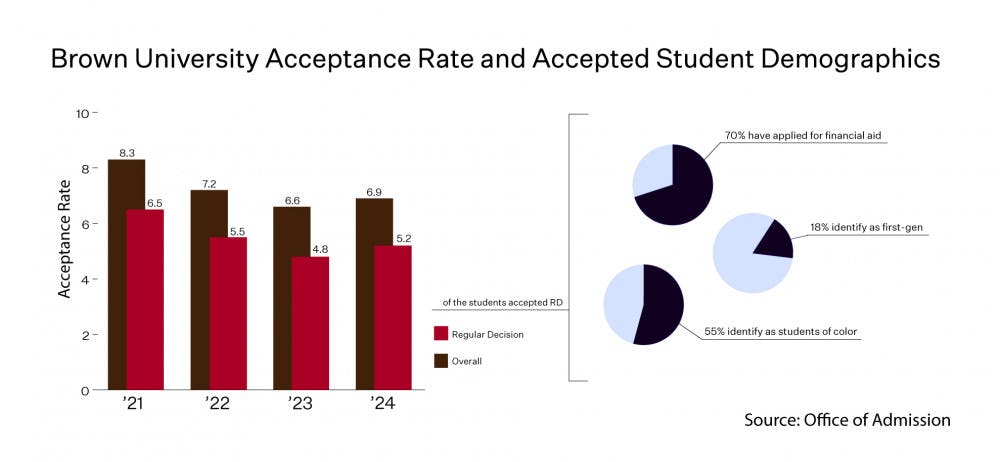The University admitted 1,732 students to the class of 2024, bringing this year’s overall acceptance rate to 6.9 percent, according to Dean of Admission Logan Powell.
The regular decision acceptance rate rose to 5.2 percent from 4.8 percent for the class of 2023. Students admitted through this round will still need to make their decisions by May 1, but the University will consider extensions on a “case-by-case” basis, Powell added.
As the COVID-19 crisis and its economic effects continue, Powell said the Office of Admission and the Office of Financial Aid are preparing for an increase in the number of students who will appeal their financial aid packages or take gap years to defer the financial stress of paying for college.
“We have to expect that there will be requests for reconsiderations and requests for changes, but we’re prepared for that,” Powell said. “We are here to be as supportive and as flexible as we possibly can be with the admitted class of 2024. We know that they are facing enormous hardships in many cases.”
To keep the size of the class consistent with past years at 1,665 students, the University may accept more students than it usually does off of its waitlist, Powell said. Additionally, the University gave out a “slightly larger” number of waitlist offers to give the admissions department “flexibility” if they need to accept more students, Powell added. The waitlist, he predicted, will have roughly 800 active students this year. In recent years, the University has admitted anywhere between two to 300 students off of the waitlist, The Herald previously reported.
“This year is more unpredictable than any we’ve had in recent memory,” he said. “We understand that this may be a different year in terms of enrollment patterns. It may be that more students decide to take a year off, and if that’s the case, then there may be more waitlist activity.”
The University will not inform waitlisted students in their admissions notifications of the potential for a greater number of open spots resulting from the greater number of admitted students who may choose to take gap years.
“We just ask them to be patient and understanding,” Powell said. “We don’t want to send misleading information without all of the best facts in hand.”
The increase in the overall acceptance rate, from 6.6 percent for the class of 2023 to 6.9 percent for the class of 2024, marks the first jump in the rate since 2016, when the University offered spots to 9 percent of applicants for the class of 2020, up from 8.5 percent the previous year.
A total of 36,794 students applied for the class of 2024, as opposed to 38,674 for the class of 2023, The Herald previously reported — the second-largest and largest application pools in University history, respectively.
“It’s still an extraordinarily selective process,” Powell said. “We’re honored that 37,000 students chose to apply. It’s humbling, and it’s incredibly gratifying.”
Fifty-five percent of the students admitted in regular decision identify as students of color, compared to 44 percent of students admitted early decision in December 2019. Outside of the United States, China, Canada, Singapore, Thailand, South Korea and the United Kingdom topped the countries represented in the class.
Seventy percent of students admitted regular decision applied for financial aid, while 62 percent of students admitted early decision applied. Currently, 43 percent of undergraduates receive need-based aid, according to an email from Dean Powell. 18 percent of admitted students are first-generation college students.
The University admitted 88 students to the Program in Liberal Medical Education out of 2,530 applicants, and 20 students to the Brown/RISD Dual Degree Program from a pool of 725 applicants.
In place of A Day on College Hill, which was canceled due to COVID-19, Powell added that the University will use Wisr — a networking software that connects different members of college communities — to facilitate virtual conversations between faculty, current students and prospective students in “communities” centered around different themes.
Potential themes could include ROTC, student centers such as the Brown Center for Students of Color and various academic concentrations, Powell said.
“It’s a great platform that allows us in real time to upload information that may be useful to (prospective students) as they consider their options,” Powell said. “It’s a great way to showcase the strength of Brown.”

Will Kubzansky was the 133rd editor-in-chief and president of the Brown Daily Herald. Previously, he served as a University News editor overseeing the admission & financial aid and staff & student labor beats. In his free time, he plays the guitar and soccer — both poorly.





